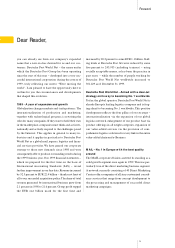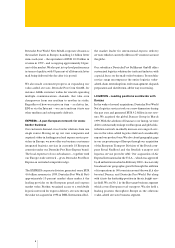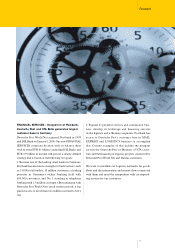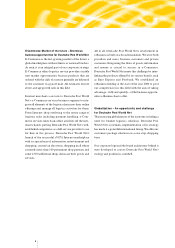DHL 1999 Annual Report Download - page 18
Download and view the complete annual report
Please find page 18 of the 1999 DHL annual report below. You can navigate through the pages in the report by either clicking on the pages listed below, or by using the keyword search tool below to find specific information within the annual report.
MAIL
An international comparison of letter item volumes per
capita reveals distinct – and, in some cases, substantial –
differences between individual countries. These differ-
ences can often be attributed to factors that are specific to
the individual country, such as the large percentage of
financial mail items (mail delivery of checks) in the
United States.
Letter items per capita
For us, this comparison with our European neighbors
and the sustained growth seen in German letter sales
point to even further growth potential. The rise of the
fax machine in the 1990s, for example, did not lead to
any significant decline in sales in Germany. Nonethe-
less, the traditional standard letter is faced with the
threat of substitution over the medium term. Sales
could fall off particularly in the area of business com-
munication (B2B) as the result of electronic data inter-
change (EDI) activities and e-mail.
By contrast, we expect to see continued growth in B2C
volume. The liberalization of Europe’s telecommunica-
tions, electricity and insurance markets has led to an
increase in the number of providers and consequently
to more letter mail, such as bills, personalized advertis-
ing (direct mail) and the like. The expansion in the
online banking business will also lead to ever-larger
B2C letter mail volume.
The spread of the Internet is bringing global transpar-
ency – and global competition. This in turn creates
more pressure to advertise.All providers have to ensure
brand awareness in their respective segments.They also
have to present and offer their products and services in
such a way that they set themselves perceptibly apart
from the competition and can consequently attract and
retain customers. For this reason, the future of market-
ing is to be found in the individual approach. Direct
advertising – addressed and unaddressed advertising
items – acts as a kind of personal messenger and opens
up an active dialogue which binds the customer to the
company on an individual basis. This increasingly calls
for target group-oriented products and services that
offer customized solutions. Sales and consultancy strat-
egies for specific industries, response processing, credit
checks and collection services are just a few of the serv-
ices that are in strong demand from small and medium-
sized businesses in particular. Paper-bound direct mail
is also expected to benefit from this scenario,even in the
Internet age. A comparison with countries, which in
some cases have even higher levels of personal com-
puter and Internet penetration, reveals the untapped
potential the German market has to offer in this area.
1999 advertising market
17
Management Report
Source: UPU 1998, * TPG for the Netherlands
*addressed and unaddressed advertising items
Sources: Zenithmedia Market Research, NUA, 1999, NOP Research
Group, Business Areane Stockholm, AIMC ProActive, Osservato-
rio Internet, IDC Research, Interactive Media Brussels, Amarach
Consulting
700
600
500
400
300
200
100
U.S.A. Nether-
lands*
France Great
Britain
Germany Spain
728
460 435
324
247
111
1.50
1.25
1.00
0.75
0.50
0.25
1,39
Percentage of
gross domestic
product
40.8 18.0 11.8 3.8 Percentage of
population
using the Internet
1.64 1.51 0.93 0.69 Total
Direct mail*
U.S.A. GB D F
1.39
1.31
0.83
0.46
0.10 0.23
0.20
0.25
Other
advertisement
























